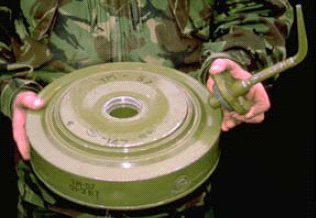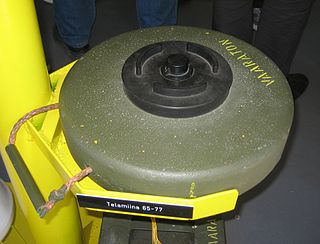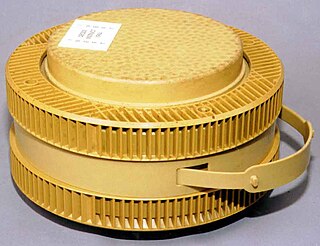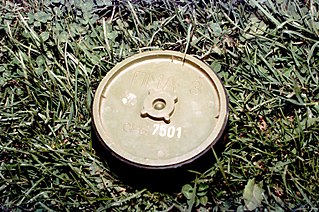Type 72 Non-Metallic is a Chinese circular, plastic bodied landmine which is designed to damage or destroy a vehicle by blast effect.

The TM-57 mine is a large, circular Soviet metal-cased blast anti-tank mine. It can either be triggered by a pressure or a tilt-rod fuze. A development of the TM-46 mine, it is found in Africa, the Middle East, and South East Asia.

The PMN series of blast anti-personnel mines were designed and manufactured in the Soviet Union. They are one of the most widely used and commonly found devices during demining operations.

The VS-1.6 is an Italian circular plastic-cased scatterable anti-tank blast mine. It has very few metal components and is resistant to overpressure and shock. The mine can also be deployed conventionally and from helicopters. It was produced by Valsella Meccanotecnica, but production has ceased.

The VS-50 is a circular plastic cased anti-personnel blast mine, formerly manufactured by the now-defunct Valsella Meccanotecnica SpA, an Italian high-tech defence industry specialized in area denial systems which was also the manufacturer of the Valmara 69 and one of the first industries in the world to implement plastic construction for landmines. The design is similar to the TS-50 and VS-MK2 mine. It is blast resistant and can be used in a minimum metal configuration. Though unlikely to kill, the explosive charge contained within a VS-50 is quite sufficient to destroy the victim's foot: the blast is capable of penetrating 5 mm of mild steel leaving an 80 mm-diameter hole.
The SB-81 is an Italian plastic cased minimum metal anti-tank blast mine dating from the early 1980s. The mine uses an air pressure based fuze, which gives it protection against overpressure and blast. It can therefore be regarded as a blast resistant mine. The mine can be scattered by hand or by mine laying systems.

The Type 72 is a Chinese metal-cased circular anti-tank blast mine, it is similar to the Russian TM-46 mine, a plastic cased version of the mine is also produced, the Type 72 non-metallic anti-tank mine. The mine has a central plastic cased blast resistant fuze.
The No 6 mine is an Israeli metal-cased anti-tank blast mine. It is a direct copy of the Russian TM-46 mine, the only notable difference being the filling cap, which is domed on the TM-46 and flat on the No 6. It can be fitted with the No 61 pressure fuze or a No 62A tilt rod fuze. The mine is found in the Falkland Islands, Israel, Lebanon and Oman.
The VS-AT4 and VS-AT4-EL are Italian minimum metal blast resistant anti-tank blast mines. The VS-AT4 uses a blast-resistant mechanical pressure fuze, while the VS-AT4-EL uses a programmable electronic pressure fuze with an integral anti-lifting function.

The TM 65 is a circular Finnish minimum metal anti-tank blast mine. It is broadly based on the Russian TM-62 mine. The mines body is made from a thin shell of fibreglass over a cast block of explosive, with a central fuze well that holds the pressure fuze. The original TM 65 used a US-65 fuze as used in the SM-65 anti-personnel mine, the later TM 65 77 uses a pressure fuze similar to the Russian MV-5 fuze called Painesytytin 77.

The TC/2.4 is a circular plastic cased Italian minimum metal anti-tank blast mine. The mine uses a blast and shock resistant pneumatic fuze. It could be laid by hand or mechanically, and could be fitted with anti-handling devices. An Egyptian copy of the mine is produced, designated as the M/80. The mine was used in Iraq, but is no longer produced.
The T-AB-1 is a rectangular plastic cased Brazilian anti-tank blast mine. The mine uses a T-AB-1 anti-personnel mine as a fuze. The AP mine is inserted into the body of the AT mine under a large stiff ABS plastic pressure plate. The pressure plate is fastened in place by a number of shear pins, which are designed to give way under a pressure of 200 kg. The AP mine under the pressure plate is then triggered, triggering the mine's main charge.
The PTM-80P is a circular plastic bodied Bulgarian minimum metal anti-tank blast mine, similar in design to the Russian TM-62P2. The mine can accept any fuze that fits into the TM-62 series of mines, including various mechanical, blast resistant, electronic, and magnetic influence fuzes. The mine is completely waterproof and can be laid in shallow water. It is currently in service with the Bulgarian armed forces.
The MAT/5 is an Italian circular, plastic-cased minimum metal blast resistant anti-tank blast mine. It uses a pneumatic fuze which is resistant to shock and blast, and is also claimed to be resistant to mine flails and mine rollers. The mine's plastic case is waterproof, and it can be laid in shallow water. Additionally the mine will function upside down. The mine can be fitted with anti-handling devices. The mine is no longer in production.
The MATS/2.6 is a scatterable Italian circular, plastic-cased minimum metal blast resistant anti-tank blast mine. It is very similar to the MATS/2, except that it uses a smooth pressure plate rather than a griddle pressure plate. It uses a pneumatic fuse which is resistant to shock and blast similar to the fuze fitted to the TS-50. The mine's plastic case is waterproof, and the mine can be scattered from a helicopter.
The Mle 1951 or MI AP ID 51 is a small circular French brown plastic cased minimum metal mine anti-personnel blast mine. The mine uses a pressure fuze that works by driving a firing pin through a friction sensitive compound. The mines safety is a small cap that sits over the pressure fuze and prevents it being pressed. The mine can be used with anti-handling devices.

The TS-50 is a 90 mm (3.5 in) diameter circular Italian blast resistant minimum metal anti-personnel mine designed and produced by Valsella Meccanotecnica.

The PMA-3 is a Yugoslavian blast resistant minimum metal anti-personnel mine. It is circular, consisting of a plastic upper and lower half joined together by a rubber cover. A safety collar is normally wrapped around the outside of the mine, preventing the upper half of the mine tilting when in transit. Once deployed the safety collar is removed. Sufficient pressure on the top surface of the mine causes it to tilt. The tilting drives a pin through a friction sensitive pyrotechnic compound, which fires the detonator and then the main explosive charge.
The M432 is a Portuguese bounding anti-personnel mine, which traces the roots of its design to the Second World War German S-mine, although it is probably more directly related to the Belgian NR 442 mine and United States M16 mine. As of 2004, all operational stocks of the mine have been destroyed, although some may have been retained for training purposes.










